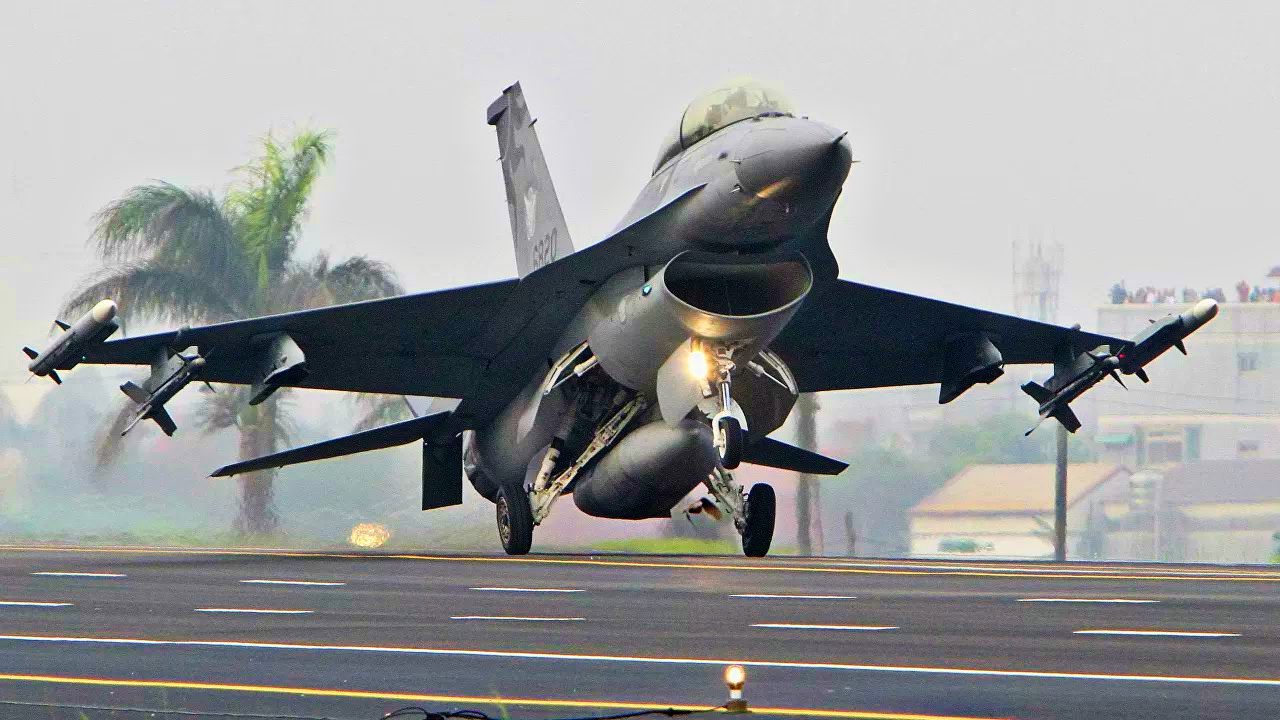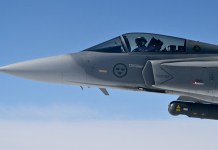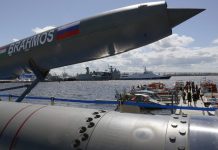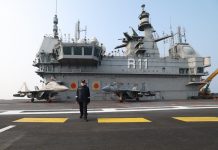Taiwan’s strategy against dynamic threats from China’s People’s Liberation Army (PLA) and whether Beijing will use larger platforms like aircraft carriers in an invasion attempt has become a center of debate among experts.
MUST READ: Naval Pilot, Flown Both Rafale & Super Hornet, Decodes Why French Jets ‘Edge Out’ US Fighters For Indian Navy Deal
An assertion by its former Chief of General Staff (CGS), Admiral Lee Hsi-ming (Li Ximing), about China’s long-range missiles and bombers being a greater threat to Taipei than its aircraft carriers has thrown up a diversity of assessments on the utility of conventional and unconventional weapons systems.
This comes at a time when the war in Ukraine has challenged certain commonly-held beliefs about modern warfare while also upholding some traditional military concepts.
Lee, speaking at an event by the Taipei School of Political Science Foundation (TSEF), said that the reach of China’s bombers, missiles, and submarines already covers the entire country (Taiwan), representing the decisive military edge.
China’s goal behind developing carriers is to “dominate and challenge the world order led by the United States,” Lee added.
Experts EurAsian Times spoke to, however, do not believe in the complete irrelevance of Chinese carrier battle groups, explaining how China would press its entire military and state resources for Taiwan operations.
Lee’s assessment has probably been influenced by China’s last year’s angry live-fire drills around Taiwan following then-US Speaker Nancy Pelosi’s visit, which witnessed a lot of firsts in the country’s military preparations for a military recourse to take the island.
This included Chinese missiles going over the island and landing on its eastern coast, simultaneous live fire drills at six locations around the island, and the use of advanced platforms like the J-20 stealth fighter.
Maverick Military Mind
Interestingly, this is not Lee’s first unorthodox take on China-Taiwan military affairs. His Overall Defense Concept (ODC) paper suggested an unconventional approach to withstand China’s overwhelming military superiority.
Recommending Taiwan use masses of multipurpose low-cost naval, aerial drones, precision-guided missiles, fast-attack craft, missile boats, mine-layers, and diverse anti-air weaponry, it envisaged Taiwan fighting a prolonged war at a strategic level in a multi-layered campaign of attrition.
Ben Lewis, an expert on the People’s Liberation Army (PLA), however, while not undermining the ODC’s utility, points to the “multifaceted threats” that China Taiwan would face, which would require conventional weapons like tanks and artillery.
He subsequently warns against disregarding the role of PLAN carriers in a Taiwan contingency, explaining that even if their employment would essentially be indirect and not actually used in striking the island, they will still be part of the larger scheme of things in the invasion.
“It is necessary to include carriers in assessments of the cross-Strait military balance,” Lewis said while speaking to the EurAsian Times.
When Missiles Flew Near & Over Taiwan
On August 4, during China’s unprecedented live-fire drills around the island following former US Speaker Nancy Pelosi’s visit to the island, Taiwan said 11 Dongfeng (DF) missiles were fired at the waters north, south, and east of the island from the Chinese side.
The Chinese missiles flew near and over Taiwan Island for the first time, a Chinese military expert, Major General Meng Xiangcing, had said. This represented a significant escalation of China’s military intimidation against Taiwan.
“We hit the targets under the observation of the US Aegis combat system, which means the Chinese military has solved the difficulties of hitting long-range targets on waters,” Meng said. “The exercises are unprecedented as the PLA conventional missiles are expected to fly over the island of Taiwan for the first time,” the Global Times report said.
One of these is believed to be the DF-17 hypersonic missile. Lee identified the other Chinese missiles as the DF-21D and DF-26, which pose a particular threat to Taiwan.
China’s state media also outlined a broad range of military objectives that its forces would have to achieve proficiently. “The exercises (are) focused on key training sessions including joint blockade, sea target assault, strike on ground targets, airspace control operation, and the joint combat capabilities of the troops got tested in the military operations,” said an announcement from the Xinhua news agency attributed to the PLA’s Eastern Theater Command.
Carriers To Challenge US, Not Attack Taiwan
China presently has two aircraft carriers, the Liaoning and the Shandong, with a third one, the Fujian, nearing completion. Lee disagreed with some analysts that China could blockade and prevent aid from reaching Taiwan by anchoring a carrier each north, east, and south of the country.
He believes the carriers would be useless for China in a Taiwan scenario, as they would not be able to withstand attacks by the US military. Lee pointed out that the CCP once said, “The strength of the navy lies where the national interests lie.” “Therefore, the CCP needs force projection, and the One Belt One Road (OBOR), etc., are all part of the global strategy, so the CCP’s development of aircraft ships has its long-range goals,” he was quoted in CNA.
The Republic of China National Defense Assessment report released at the TSEF event also emphasized the importance of cybersecurity and countering ‘gray zone tactics’ and hostile actions that stop short of outright warfare.
Lee said if the ‘gray zone’ is enlarged without limit, and more fighters and ships are purchased to deal with it, it will seriously deplete the allocation of military resources and disrupt the priority order.
In his ODC, he also advises against spending on capital and bigger weapons platforms like fighter jets, tanks, and howitzers for purposes of less military utility.
But Lewis believes the ODC to be an “overreaction” to Chinese military threats of large-scale operations around Taiwan, where adopting a totally asymmetric strategy might eliminate the lack of depth in some areas but would almost certainly create problems in several other areas.”
The ongoing Russia-Ukraine war and the evolution of conventional and unconventional weapons platforms largely validate Lewis’s idea. Asymmetric platforms like suicide drones (specialized military UAVs and commercial aircraft rigged for battlefield use) have redefined tactical strikes, surveillance, and reconnaissance.
But conventional weapons like gun and tube rocket artillery, tanks, infantry fighting vehicles, bloody trench, and urban warfare involving infantry and ground attack by aircraft and helicopters have as much been a reality.

Gray Zone Warfare
Gray zone warfare involves encircling the enemy using overwhelming military force that instills the fear of escalation and deterrence, dithering them from resorting to kinetic attacks and preventing actual war. This helps China attain many of its tactical and semi-strategic objectives without resorting to combat.
Lee’s take also aligns with other previous analyses that have noted this Chinese approach, common across the South China Sea (SCS), Taiwan Strait, and even Ladakh, where it has territorial disputes.
John Culver, former US National Intelligence Officer for East Asia, believes China respects the adversary’s “will to fight and maintain a posture for a long time.” “Rather than invade Taiwan, it would take advantage of the psychological impact on Taiwan to press for negotiations,” Culver said in an article in The Interpreter.
Conventional Weapons
Going by Culver’s reasoning, such a stamina for war cannot conceivably be sustained by just asymmetric forces, especially if the will to fight has to be translated into actual combat. During a Taiwan scenario, according to Lewis, China will not only use “missiles, submarines, and bombers in direct offensive operations” but all tools in its arsenal, including gray zone warfare and asymmetric weapons.
For instance, cutting off internet cables to disrupt civilian-military command and pressure Taiwanese citizens by surrounding, encircling, and possibly deciding to land troops to effect simultaneous all-aspect warfare is one strategy China is likely to employ.
Open-source academic material on Chinese military thought suggests the rationale is to present a heavily outsized and colossal overwhelming picture of a creeping military invasion to Taiwanese planners. In theory, it is expected to coerce them into submission and prevent either kinetic war or further escalation.
This scenario would need what Lewis calls a “flexible ‘Syncretic Defense’ strategy to counter whatever form the Chinese threat takes.” This involves mutually supporting and complementing conventional forces, asymmetric militias, and locally integrated reserve units.

Taiwan Must Be Able To Fight Independently
But the will and ability to fight itself are determined by the readiness of one’s weapons platforms. A previous EurAsian Times analysis showed China is impacting the availability of Taiwanese fighters by forcing them to undertake useless interceptions when it sends drones and aircraft into its Air Defense Identification Zone (ADIZ). This increases their wear and tear, relegating them to repairs.
But Lewis says Taiwan has got around this too, where the Ministry of Defense (MND) has “switched from sending its own aircraft to monitor every flight to only scrambling aircraft in specific circumstances.”
In summary, Taiwan needs strong naval and land forces to hold the line and dynamically challenge a PLA threat without being dependent on outside intervention from the United States, as the ODC is.
- The author can be reached at satamp@gmail.com
- Follow EurAsian Times on Google News




